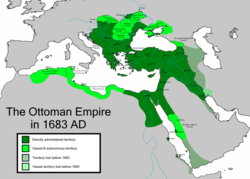
Back Османтәи аимпериа Abkhazian Turuki Utsmani ACE Осмэн Пачъыхьыгъо ADY Ottomaanse Ryk Afrikaans Osmanisches Reich ALS የኦቶማን መንግሥት Amharic Imperio Otomán AN Oþomanisce Rīce ANG Ijọn̄-ubọọn̄ Otoman ANN الدولة العثمانية Arabic
This article includes a list of references or other websites, but its sources remain unclear because it does not have enough inline citations. (June 2022) |
The Sublime Ottoman State Ottoman Empire Osmanlı İmparatorluğu دولت عالیه عثمانیه Devlet-i Aliyye-i Osmâniyye | |||||||||||||||||||||||
|---|---|---|---|---|---|---|---|---|---|---|---|---|---|---|---|---|---|---|---|---|---|---|---|
| 1299–1923 | |||||||||||||||||||||||
| 'Motto: 'دولت ابد مدت Devlet-i Ebed-muddet ("The Eternal State") | |||||||||||||||||||||||
| Anthem: (various) | |||||||||||||||||||||||
 Ottoman Empire at its peak in 1683. | |||||||||||||||||||||||
| Status | Empire | ||||||||||||||||||||||
| Capital | Söğüt (1299–1326) Bursa (1326–1365) Edirne (1365–1453) Constantinople (1453–1922) | ||||||||||||||||||||||
| Government |
| ||||||||||||||||||||||
| Sultans | |||||||||||||||||||||||
• 1281–1326 (first) | Osman I | ||||||||||||||||||||||
• 1918–22 (last) | Mehmed VI | ||||||||||||||||||||||
| Grand Viziers | |||||||||||||||||||||||
• 1320–31 (first) | Alaeddin Pasha | ||||||||||||||||||||||
• 1920–22 (last) | Ahmed Tevfik Pasha | ||||||||||||||||||||||
| History | |||||||||||||||||||||||
• Founded | 1299 | ||||||||||||||||||||||
| 1402–1413 | |||||||||||||||||||||||
| 1876-1878 | |||||||||||||||||||||||
| 1908-1918 | |||||||||||||||||||||||
| July 24 1923 | |||||||||||||||||||||||
| Area | |||||||||||||||||||||||
| 1680 | 5,500,000 km2 (2,100,000 sq mi) | ||||||||||||||||||||||
| Population | |||||||||||||||||||||||
• 1856 | 35350000 | ||||||||||||||||||||||
• 1906 | 20884000 | ||||||||||||||||||||||
• 1914 | 18520000 | ||||||||||||||||||||||
• 1919 | 14629000 | ||||||||||||||||||||||
| Currency | Akçe, Kuruş, Lira | ||||||||||||||||||||||
| |||||||||||||||||||||||
| Today part of | |||||||||||||||||||||||
The Ottoman Empire existed between 1299 and 1923. It controlled the regions from Balkans to Arabia and from Black Sea to North Africa. It was founded as a small tribe and became a major power in 16th century. Its capital was Constantinople (now Istanbul).
The Ottomans originate from the Turkic tribes that escaped from Mongol invasion around 1250. It was formed as a chiefdom in modern-day Bilecik. The Ottomans quickly captured vast territories around Balkans and Anatolia and they conquered Constantinople in 1453.
Ottoman society was multicultural, with Muslims, Catholics, Orthodoxs and Jews. The religious groups had autonomy under the millet system. Until 19th century, most non-Muslims did not join the army and paid an exemption tax (jizye). Christian boys were recruited to the Ottoman army with devşirme system. They were trained to become loyal soldiers and administrators for the Sultan.
With the capture of Levant and Egypt in 1517, the Empire controlled Mediterranean trade routes. This provided a great source of income during the 16th century but became unprofitable with the discovery of Americas. In the 17th century, long wars with Austria, Poland, Russia and Iran weakened the state, and the Empire.
In the beginning of the 18th century, Ottoman society enjoyed relative peace. There was rich cultural activity during what is now known as Tulip period. Between 1735 and 1792, the Ottoman Empire fought wars against Russian Empire and lost the control of the Black Sea.
After the French Revolution of 1789, Christian minorities began independence movements. In the 19th century, the Ottoman Empire implemented military, economic and social reforms. Britain, France and Russia partitioned the remaining Ottoman territories in Africa and the Balkans.
In the 20th century, the Ottoman Empire allied with the German Empire and joined the Central Powers. The government surrendered in 1918 with the armistice of Mudros and signed the Treaty of Sèvres in 1920. Turkish nationalists, who disliked the treaty, started a civil war against the monarchy and the invading armies. The civil war ended in 1923 with the Treaty of Laussane, and the Turkish Republic was proclaimed.
- ↑ Finkel, Caroline (2005). Osman's Dream: The Story of the Ottoman Empire, 1300–1923. New York: Basic Books. pp. 110–1. ISBN 978-0-465-02396-7.
- ↑ The Treaty of Sèvres (10 August 1920) afforded a small existence to the Ottoman Empire. The ending of the Ottoman Sultanate in November 1, 1922, did not end the Ottoman State, but only the Ottoman dynasty. The official end of the Ottoman State was declared through the Treaty of Lausanne (July 24, 1923). It recognized the new "Ankara government", not the old Constantinople-based Ottoman government, as representing the rightful owner and successor state. The Grand National Assembly of Turkey declared the successor state to be the "Republic of Turkey" (October 29, 1923) less than a month after its international recognition as a state.

